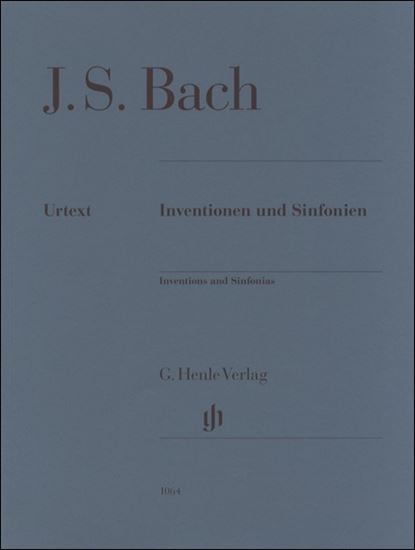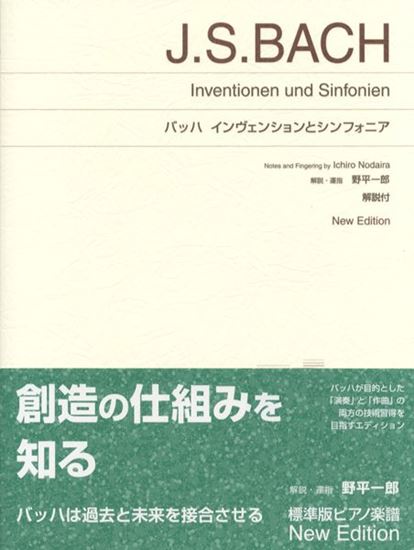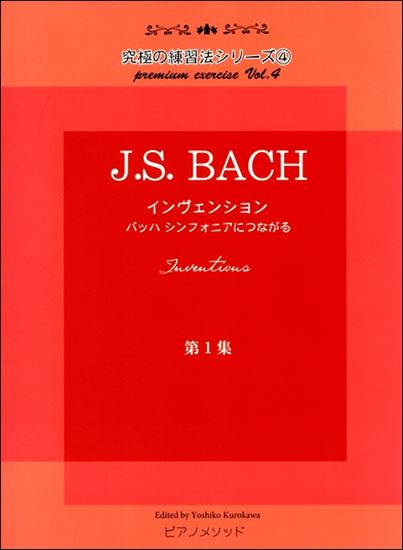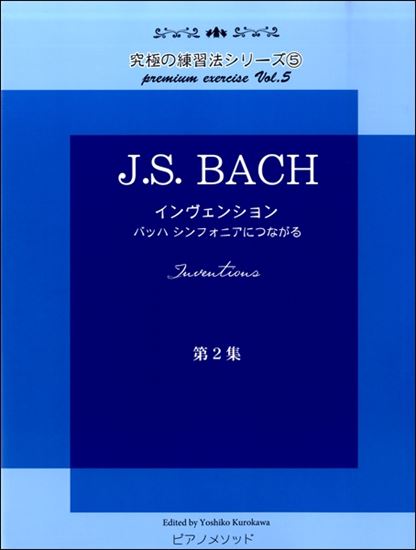Bach, Johann Sebastian : Invention BWV 772-786
Work Overview
Publication Year:1801
First Publisher:Breitkopf und Härtel
Instrumentation:Piano Solo
Genre:pieces
Total Playing Time:19 min 30 sec
Copyright:Public Domain
Commentary (2)
Author : Asayama, Natsuko
Last Updated: January 1, 2010
[Open]
Author : Asayama, Natsuko
“A sincere guide, wherein lovers of the clavier, and especially those desirous of learning, are shown a clear method not only (1) to play two voices cleanly, but also, upon further progress, (2) to handle three obbligato voices correctly and skillfully, and at the same time, not merely to acquire inventions, but to develop them skillfully, and above all, to acquire a firm cantabile style of playing, and furthermore, to be taught a clear method for cultivating a strong interest in composition. Completed by Johann Sebastian Bach, Capellmeister to the Prince of Anhalt-Cöthen. 1723.”
Bach himself inscribed this on the title page of the completed collection. The Inventions and Sinfonias are revisions of short pieces compiled for the lessons of his eldest son, Friedemann, and thus, by their very origin, possess the character of a pedagogical work. But what is the true meaning of what is written here?
Bach began the training of musicians by having them acquire keyboard playing technique using both hands. This was to acquire a more natural musicality by connecting it with hand movements. However, the method employed here is not the basso continuo peculiar to the Baroque era, i.e., supplementing the bass with appropriate chords in the right hand. All voices are indispensable “obbligato” parts, written to be played “cantabile.” And each independent voice merges into one within the harmony. Strict counterpoint and cantabile, melody and harmony. The seemingly simple two- and three-voice works actually bear the significant aesthetic proposition of “unity in diversity” from the 16th-17th centuries.
The word “Inventio” in Bach’s message is also related to the aesthetics and compositional methods of older music. This term originates from rhetoric and is often translated as “idea” or “conception,” but it originally means “discovery” (not “invention”). That is, to find expressions appropriate to the content one wishes to convey. To do so, one must learn as many rhetorical figures (figurae) as possible and understand their arrangement. The Inventions and Sinfonias are written as exemplars of this, showcasing the extremely diverse styles of Bach’s keyboard music. They are, so to speak, a microcosm of Bach’s musical world.
Therefore, “Invention” is by no means a term representing a specific genre or musical form. While some collections by German composers before Bach bear this title, there is no formal unity or commonality among them. After Bach, if the term “Invention” is used in a general sense in musical analysis, it would be in a positive context, referring to a concise yet well-structured contrapuntal work exemplary in style and technique, or as an homage to Bach’s masterful compositions.
The composition period is 1720-23, a time when Bach was employed at the court of Cöthen and produced numerous instrumental works. In 1720, Bach began compiling a music notebook for his eldest son, Friedemann, who was then 10 years old. In this notebook, two-voice Praeludia and three-voice Fantasias were inscribed in the order of C major, D minor, E minor, F major, G major, A minor, B minor, B-flat major, A major, G minor, F minor, E major, E-flat major, D major, C minor (though the three-voice C minor is missing). The arrangement was related to the number of key signatures. When he fair-copied this in 1723, he revised the pieces themselves, rearranged them in diatonic order, and named the two-voice pieces Inventions and the three-voice pieces Sinfonias.
※ Please also refer to the section on ‘Sinfonia’.
No. 5 in B-flat major, BWV 776
Since the subject and countersubject are presented simultaneously from the outset, the piece takes on the character of a double fugue. The two subjects contain all sorts of contrasts, such as ascending and descending motion, a leisurely rhythm with ornaments versus perpetual motion in sixteenth notes, and arpeggiated chords versus stepwise motion. Consequently, even without overly complex contrapuntal treatment, merely interchanging the voices of each motive generates a wide variety of variations. Furthermore, the performer can freely add ornaments to imbue the progression of the piece with their own unique color.
Another reason why this piece, despite its very few motives, does not become monotonous lies in the skillful use of sequential progression to create key transitions. Since the subject itself ends on the dominant, after starting in E-flat major, it immediately moves to the dominant key (B-flat major). Thereafter, the opening motif, usually repeated twice, is repeated five times, including in the left hand, opening the way to C minor. However, in measure 15, by changing the ascending arpeggiated octave to a minor seventh, F minor is secured. This technique is repeated in the next four measures, leading temporarily to B-flat minor. But even this is thwarted as the opening motive, which should have continued ascending from measure 20, descends instead, pushing it back to F minor. Thus, in the middle section, unstable minor key areas persisted, but by having both hands leap by a second multiple times in measure 24, it finally breaks out into A-flat major, achieving a return to E-flat major in the next statement. In this way, the entire piece weaves a drama around the tonic key.
Author : Takamatsu, Yusuke
Last Updated: September 18, 2020
[Open]
Author : Takamatsu, Yusuke
General Introduction
The two collections, the Inventions and Sinfonias, were created with an educational purpose, as explicitly stated by Bach in his preface: to provide "proper instruction."
The individual pieces now known as the Inventions and Sinfonias were, before being compiled into these collections, contained in a music notebook titled Clavier-Büchlein vor Wilhelm Friedemann Bach, which Bach compiled over several years starting in 1720 as teaching material for his eldest son. This notebook includes explanations of notation and ornamentation, finger exercises, followed by a collection of short pieces, both his own and by other composers. Among these short pieces, after minuets and praeludia (some of which would later be included in The Well-Tempered Clavier, Book I), the works that would eventually comprise the Inventions and Sinfonias were written under the titles "Praeludium" and "Fantasia."
Thus, while this music notebook contained various pieces, The Well-Tempered Clavier, Book I and the Inventions and Sinfonias were later compiled as independent collections, each with its own cover. In other words, "Inventions and Sinfonias" and "The Well-Tempered Clavier" originated at the same time with the same purpose, but were re-edited with different emphases.
In this collection, the title was changed from "Praeludium" (Prelude) in the music notebook to "Inventio." During the Baroque era, music theory was developed based on ancient Greek and Roman rhetoric, and the compositional process was also theorized in three stages, following rhetorical principles: "Inventio" (conception/invention), "Dispositio" (arrangement/disposition), and "Elaboratio" (elaboration/refinement). Therefore, "Invention" refers to the "conception" of the core musical idea of a piece. However, this implies not merely conceiving a melody, but devising an inventive subject capable of structuring the entire composition and leading to further compositional processes or improvisational development. At that time, composition and performance were inextricably linked, and thus the two collections, the Inventions and Sinfonias, were compiled to enable the proper acquisition of both compositional and performance techniques.
The Inventions are written for two voices and are thought to have been composed for the clavichord. The entire collection is arranged in ascending key order, from C major in No. 1 to B minor in No. 15.
Bibliography
- Ichida, Giichiro. 1971. Bach: Inventions and Sinfonias. Tokyo: Ongaku no Tomo Sha.
- Higuchi, Ryuichi, et al. 1996. Bach Complete Works Vol. 11: Harpsichord Works [1]. Tokyo: Shogakukan.
- Isoyama, Tadashi, Yoshitake Kobayashi, and Fumio Narumi, eds. 1996. Bach Jiten (Bach Encyclopedia) (Complete Works Commentary Encyclopedia). Tokyo: Tokyo Shoseki.
- Geck, Martin. 1998. Große Komponisten: Bach. Translated by Kinya Osumi. Tokyo: Ongaku no Tomo Sha.
- Kokaji, Kunitaka, and Masako Nakai. 2005. Bach Inventions: A Guide to Analysis and Performance. Tokyo: Chopin.
- Maruyama, Keisuke. 2020. Bach: The Cosmology of Inventio. Tokyo: Shunjusha.
- Küster, Konrad (ed.). 1999. Bach-Handbuch. Bärenreiter & J. B. Metzler.
No. 1 in C major, 4/4 time
The "Inventio" (conception) of this piece is found in the subject presented through imitation in both voices. This concise subject is ingeniously developed contrapuntally throughout the piece, for instance, by being repeated a fifth higher in measure 2, and by having its opening motive used in sequential progression from measure 3.
The piece consists of three exposition sections. Following the first exposition in the opening six measures, a second exposition (measures 7–15) progresses through G major, D minor, and A minor, followed by a third exposition (measures 15–22) leading from A minor back to the tonic C major.
As an example of "Elaboratio" (elaboration), the technique of developing a concise motive is notable. This can be seen, for instance, in the sequential progression from measure 3, where an inversion of the opening motive is used, and further, where an inversion of this sequence appears from measure 19. Another example is from measure 15, where both voices alternately imitate the opening motive and its inversion.
No. 2 in C minor, 4/4 time
The "Inventio" (conception) of this piece involves a subject devised with the technique of canon in mind. It is noteworthy as the only canonic keyboard piece composed before the Goldberg Variations (BWV 988).
The entire piece is divided into three sections. In the first exposition, the lower voice follows the upper voice with a two-measure delay (measures 1–10). In the subsequent ten measures, the lower voice repeats the upper voice's material from the first development section in the dominant key of G minor, with the upper voice designed to follow it. Thus, the second exposition (measures 11–20) maintains the same structure as the first exposition while employing voice exchange. The final seven measures are not canonic, forming a coda through imitation of the subject after a two-measure introduction.
No. 3 in D major, 3/8 time
The subject is presented in the opening 12 measures, and its final cadence (measures 11–12) determines the overall structure of the piece. The middle section consists of two parts, separated by a cadence in B minor (measures 23–24) and a cadence in A major (measures 37–38). From measure 43, the opening subject returns, forming the final exposition. Unusually for the Inventions, the end of the piece features two cadences: a deceptive cadence (measures 53–54) and a perfect authentic cadence (measures 58–59), with the coda being repeated. This structure, where the musical character changes with cadences, is reminiscent of the ritornello form, a principle of the Baroque concerto.
No. 4 in D minor, 3/8 time
This piece is constructed by the constant repetition of the two-measure opening subject, presented by the upper voice, throughout the entire composition. In this sixteenth-note subject, the diminished seventh leap in measure 2 creates a severe musical character.
The sixteenth-note subject flows continuously, but points where it breaks form cadences, corresponding to structural divisions in the piece (measures 17, 37, 48, 51). This subject appears in various transformed shapes, such as being repeated as a sequential progression (upper voice from measure 5, lower voice from measure 11) or used in inversion (measures 22–25).
No. 5 in E-flat major, 4/4 time
This piece is written in a fugal style and consists of three exposition sections.
First, the upper voice presents a four-measure subject at the beginning, followed by the lower voice responding in the dominant key in the subsequent four measures (first exposition). After a three-measure interlude consisting of a sequential progression of the opening motive, the subject is presented in C minor and F minor from measure 12 (second exposition). Following another three-measure interlude, and then a presentation of only the opening motive of the subject (in the subdominant) and its response (in the tonic), the subject returns in the tonic from measure 27 (third exposition), concluding the piece.
No. 6 in E major, 3/8 time
The characteristic "Inventio" (conception) of this piece is likely the syncopation in both voices. At the beginning, while the lower voice ascends diatonically, the upper voice descends chromatically, offset by a half-beat. Furthermore, this four-measure subject is repeated with the voices exchanged (this contrapuntal technique of exchanging multiple voices is called invertible counterpoint).
It is also noteworthy that this is the only piece among the Inventions that includes repeat signs within the piece. The first half (A), delimited by these repeat signs, progresses from E major to the dominant B major. The second half consists of a developmental middle section (B) and a return of A, which closes the piece in the tonic (||:A:||:BA:||). This scheme (a two-part form with a return of A) indicates an approach to instrumental forms that would later be theorized as "sonata form" in the first half of the 19th century.
No. 7 in E minor, 4/4 time
This piece, like No. 1, is constructed through the manipulation of a concise motive. The motive presented at the beginning is repeated in various forms, such as being transposed (sequential progression) or used in inversion.
The entire piece consists of three exposition sections. The first exposition, starting from measure 1, develops through imitation and sequential progression of the subject, concluding with a half cadence in measure 7. In the second exposition (measures 7–15), with the dominant of G major sustained as a pedal point, the lower voice develops by elaborating on the opening motive. The development continues after the pedal point, but the first measure of the subject is divided into a sixteenth-note first half and a dotted-rhythm second half, each processed separately. From measure 15 (third exposition), with the lower voice as a pedal point, the upper voice undergoes free development, which is then taken over by the lower voice, preparing for the concluding section from measure 20.
No. 8 in F major, 3/4 time
A lively piece that opens with fanfare-like ascending arpeggiated chords. It consists of three exposition sections, with the first and third expositions featuring a canon where the lower voice follows the upper voice with a one-measure delay.
The second exposition (from measure 12) opens with the upper voice imitating the C major subject presented by the lower voice, but instead of continuing as a canon, it modulates repeatedly, starting in G minor, using previously introduced motives.
From the third exposition (from measure 26), it becomes a canon again, but the recapitulation of the subject's opening is omitted, corresponding to measures 4–12.
No. 9 in F minor, 3/4 time
While the subjects of the other Inventions are generally concise, the subject of this piece is comparatively long, spanning four measures. The emotionally rich melody in F minor is particularly suitable for learning the "cantabile manner" that Bach mentioned in his preface.
The piece can be divided into exactly two parts. In the first half, the upper voice first presents the subject, while the lower voice plays a countersubject as if accompanying it. Then, from measure 5, both voices invert, and from measure 9, the piece modulates using the subject and countersubject. In the second half (from measure 17), contrary to the beginning, the lower voice presents the subject in the dominant key.
No. 10 in G major, 9/8 time
A lively piece characterized by arpeggiated figures. Its connection to improvisational techniques has been noted; indeed, the subject, composed of broken chords, is well-suited for improvising while considering harmonic progressions. As evidence, the harmony generally changes every measure, and modulation through the repetition of the same figure at different pitches (sequential progression) is frequently employed. In Bach's time, performance and composition were inextricably linked, so this piece likely includes an educational intent to demonstrate how to perform and compose through improvisational skill.
The piece is structured in two parts. In the second half (from measure 14), the lower voice presents the subject in the dominant key, and the upper voice responds a fifth higher.
No. 11 in G minor, 4/4 time
This piece possesses a sorrowful character, underscored by a chromatic descent of a fourth.
In the Baroque era, the essence and purpose of music were understood to be the expression or evocation of "Affekt" (affect). This referred not to individual "emotions" as currently conceived, but to typified and objectified states such as "joy," "sorrow," or "suffering." The countersubject played by the lower voice at the beginning has a descending chromatic scale over a fourth (G–F#–F–E–Eb–D) as its core, which is a conventional means of expressing the affect of "sorrow" (known as "passus duriusculus"). This chromatic countersubject always appears in combination with the subject.
The piece is composed of two parts, with the second half beginning at measure 11. In both halves, sixteenth notes continuously resound in one of the voices, designed to flow throughout the entire piece.
No. 12 in A major, 12/8 time
This piece consists of three exposition sections and two interludes. In the opening two measures, the upper voice presents the subject and the lower voice presents the countersubject, which are then repeated a fifth higher with the voices exchanged. This subject appears in F-sharp minor (from measure 9) and C-sharp minor (from measure 11) in the second exposition, and then the lower voice plays it in the tonic in the third exposition (from measure 18).
Similar to the previous piece, it is constructed so that sixteenth notes continuously resound throughout the entire piece, with the exception of the final cadence.
No. 13 in A minor, 4/4 time
This piece, like Nos. 11 and 12, possesses a kind of perpetuum mobile character due to the constant sounding of sixteenth notes. The subject is constructed from arpeggiated chords, and combined with the frequent use of sequential progression (repetition of the same figure at different pitches), it is also characterized by rapid changes in musical character due to harmonic shifts.
This piece is divided into two halves, and the first half also consists of two exposition sections. The second exposition (measures 6–13), while more developmental and slightly longer than the first exposition (measures 1–6), is essentially a transposition of the first exposition to the relative key with the voices exchanged.
No. 14 in B-flat major, 4/4 time
This piece has a festive character. The subject is based on arpeggiated chords, with thirty-second note passing tones in runs adding brilliance.
The piece consists of four sections. After the subject is presented in the first section (measures 1–5), the second section (measures 6–11) features the subject presented in the dominant key with voice exchange, while modulating. In the third section (measures 12–16), a canon unfolds where the upper voice follows the lower voice, and in the fourth section (measures 16–20), the subject is recapitulated in a canonic manner.
No. 15 in B minor, 4/4 time
This piece has the character of a "Capriccio," written in a relatively free form while employing contrapuntal writing. Broadly, it is divided into three exposition sections (measures 1–7, 12–15, 18–22) and interludes (measures 7–12, 16–19). In the exposition sections, the subject is presented in various keys, while in the interludes, modulation occurs through sequential progression, repeating a fixed musical figure at different pitches.
At the end of the piece, it is explicitly stated, "Here follow 15 Sinfonias for three voices," indicating that the learner is intended to proceed to the next step.
Movements (15)
Arrangements & Related Works(1) <Show>
Thompson, John Sylvanus: Second Piano Accompaniments to Five Two-Part Bach Inventions
Total Performance Time: 7 min 00 sec
PTNA & Partner Channel Videos(120items) View More
Reference Videos & Audition Selections(11items)
Sheet MusicView More
Scores List (104)

(株)エー・ティ・エヌ

(株)エー・ティ・エヌ

(株)全音楽譜出版社

(株)音楽之友社

(株)全音楽譜出版社

カワイ出版

(株)ヤマハミュージックエンタテインメントホールディングス
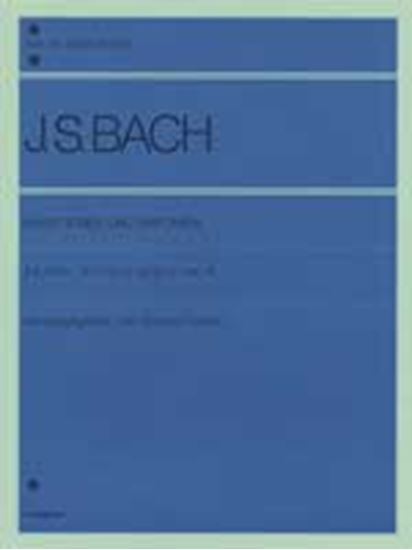
(株)全音楽譜出版社
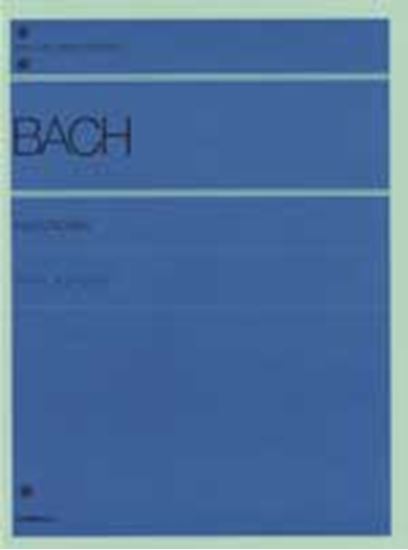
(株)全音楽譜出版社

(株)ヤマハミュージックエンタテインメントホールディングス

(株)ドレミ楽譜出版社

(株)ヤマハミュージックエンタテインメントホールディングス

(株)ヤマハミュージックエンタテインメントホールディングス

(株)ヤマハミュージックエンタテインメントホールディングス

(株)リブロポート

(株)ドレミ楽譜出版社

(株)ヤマハミュージックエンタテインメントホールディングス

(株)全音楽譜出版社

(株)ドレミ楽譜出版社

(株)ドレミ楽譜出版社

(株)ドレミ楽譜出版社

(株)音楽之友社

(株)全音楽譜出版社

(株)音楽之友社

(株)音楽之友社

(株)ドレミ楽譜出版社

(株)ドレミ楽譜出版社

(株)ドレミ楽譜出版社

(株)ドレミ楽譜出版社

カワイ出版

(株)渓水社

(株)音楽之友社

(株)全音楽譜出版社

(株)エー・ティ・エヌ

(株)全音楽譜出版社

カワイ出版

(株)音楽之友社

(株)音楽之友社

(株)東音企画(バスティン)

(株)ヤマハミュージックエンタテインメントホールディングス

(株)東音企画(バスティン)

(株)ヤマハミュージックエンタテインメントホールディングス

(株)全音楽譜出版社

(株)学研プラス

(株)音楽之友社

(株)ヤマハミュージックエンタテインメントホールディングス

(株)ヤマハミュージックエンタテインメントホールディングス

(株)ヤマハミュージックエンタテインメントホールディングス

(株)音楽之友社

(株)音楽之友社

Neil A. Kjos Music Company

Neil A. Kjos Music Company

Neil A. Kjos Music Company

Neil A. Kjos Music Company

Neil A. Kjos Music Company

Neil A. Kjos Music Company

Neil A. Kjos Music Company

Neil A. Kjos Music Company

Neil A. Kjos Music Company

Neil A. Kjos Music Company

Neil A. Kjos Music Company

Neil A. Kjos Music Company

Neil A. Kjos Music Company

Neil A. Kjos Music Company

Neil A. Kjos Music Company

Musikverlag Doblinger

Musikverlag Doblinger

Peters

Peters

Peters

Peters

Peters

Peters

Peters

Peters

Peters

Peters

Peters

Peters

Peters

Peters

Peters

ミュッセ





























